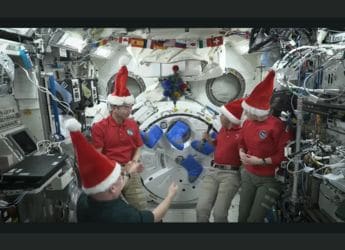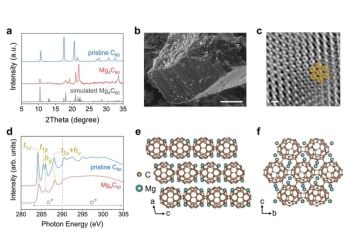- Home
- Science
- Science News
- Hubble Telescope Captures NGC 4536, a Starburst Galaxy with Intense Star Formation
Hubble Telescope Captures NGC 4536, a Starburst Galaxy with Intense Star Formation
NASA’s Hubble captures NGC 4536, a starburst galaxy in Virgo with intense star formation and glowing gas clouds.

Photo Credit: NASA, ESA, and J. Lee (Space Telescope Science Institute
NGC 4536 is a starburst spiral galaxy with bright blue star clusters and pink hydrogen clumps
A striking image of the starburst galaxy NGC 4536 has been released by NASA, showcasing its vivid blue star clusters and glowing pink hydrogen gas. Situated approximately 50 million light-years from Earth in the Virgo constellation, this intermediate spiral galaxy displays a dynamic environment where new stars are forming at an accelerated rate. The image, taken by the Hubble Space Telescope, highlights a bright central region encircled by sweeping spiral arms teeming with stellar nurseries. The rapid formation of stars in NGC 4536 has placed it in the category of starburst galaxies, which exhibit significantly higher star formation rates than the average galaxy.
Intensified Star Formation Due to Galactic Interactions
According to NASA, gravitational interactions or concentrated gas accumulation in a compact region often trigger starburst activity. In the case of NGC 4536, its bar-like structure is believed to channel gas toward the core, intensifying the process. The galaxy is a part of the M61 Group within the Virgo Cluster, where the gravitational influence of nearby galaxies contributes to compressing interstellar gas, providing favourable conditions for stellar birth.
Impact of Stellar Explosions on the Galaxy
Massive, hot blue stars are being rapidly produced in this galaxy, but their short lifespans lead to intense ultraviolet radiation emissions. These stars burn out quickly, ending their cycles in supernovae that disperse energy across the surrounding regions. This ultraviolet radiation ionizes hydrogen gas, creating luminous pink regions known as HII zones. The presence of these zones, visible in the Hubble image, indicates areas where new stars are emerging.
Part of a Broader Astronomical Study
This image was taken as part of a broader effort to investigate the relationship between young stars and interstellar gas in nearby galaxies. By examining starburst environments like NGC 4536, astronomers aim to gain deeper insights into how galaxies evolve and how interstellar material influences the birth of stars.
Get your daily dose of tech news, reviews, and insights, in under 80 characters on Gadgets 360 Turbo. Connect with fellow tech lovers on our Forum. Follow us on X, Facebook, WhatsApp, Threads and Google News for instant updates. Catch all the action on our YouTube channel.
Related Stories
- Samsung Galaxy Unpacked 2025
- ChatGPT
- Redmi Note 14 Pro+
- iPhone 16
- Apple Vision Pro
- Oneplus 12
- OnePlus Nord CE 3 Lite 5G
- iPhone 13
- Xiaomi 14 Pro
- Oppo Find N3
- Tecno Spark Go (2023)
- Realme V30
- Best Phones Under 25000
- Samsung Galaxy S24 Series
- Cryptocurrency
- iQoo 12
- Samsung Galaxy S24 Ultra
- Giottus
- Samsung Galaxy Z Flip 5
- Apple 'Scary Fast'
- Housefull 5
- GoPro Hero 12 Black Review
- Invincible Season 2
- JioGlass
- HD Ready TV
- Laptop Under 50000
- Smartwatch Under 10000
- Latest Mobile Phones
- Compare Phones
- Honor Win RT
- Honor Win
- Xiaomi 17 Ultra Leica Edition
- Xiaomi 17 Ultra
- Huawei Nova 15
- Huawei Nova 15 Pro
- Huawei Nova 15 Ultra
- OnePlus 15R
- Asus ProArt P16
- MacBook Pro 14-inch (M5, 2025)
- OPPO Pad Air 5
- Huawei MatePad 11.5 (2026)
- Xiaomi Watch 5
- Huawei Watch 10th Anniversary Edition
- Acerpure Nitro Z Series 100-inch QLED TV
- Samsung 43 Inch LED Ultra HD (4K) Smart TV (UA43UE81AFULXL)
- Asus ROG Ally
- Nintendo Switch Lite
- Haier 1.6 Ton 5 Star Inverter Split AC (HSU19G-MZAID5BN-INV)
- Haier 1.6 Ton 5 Star Inverter Split AC (HSU19G-MZAIM5BN-INV)

















